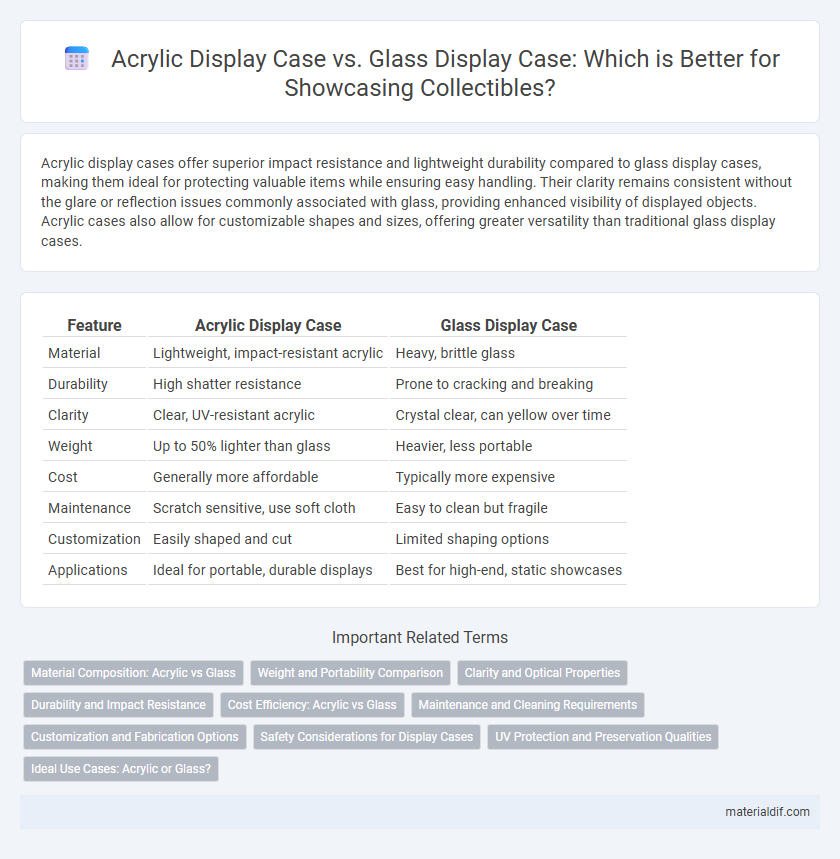Acrylic display cases offer superior impact resistance and lightweight durability compared to glass display cases, making them ideal for protecting valuable items while ensuring easy handling. Their clarity remains consistent without the glare or reflection issues commonly associated with glass, providing enhanced visibility of displayed objects. Acrylic cases also allow for customizable shapes and sizes, offering greater versatility than traditional glass display cases.
Table of Comparison
| Feature | Acrylic Display Case | Glass Display Case |
|---|---|---|
| Material | Lightweight, impact-resistant acrylic | Heavy, brittle glass |
| Durability | High shatter resistance | Prone to cracking and breaking |
| Clarity | Clear, UV-resistant acrylic | Crystal clear, can yellow over time |
| Weight | Up to 50% lighter than glass | Heavier, less portable |
| Cost | Generally more affordable | Typically more expensive |
| Maintenance | Scratch sensitive, use soft cloth | Easy to clean but fragile |
| Customization | Easily shaped and cut | Limited shaping options |
| Applications | Ideal for portable, durable displays | Best for high-end, static showcases |
Material Composition: Acrylic vs Glass
Acrylic display cases are made from polymethyl methacrylate (PMMA), a lightweight and shatter-resistant plastic known for its superior clarity and UV resistance compared to traditional glass. Glass display cases consist of silica-based materials, offering excellent scratch resistance and a higher hardness level but are heavier and more fragile. The choice between acrylic and glass depends on the need for durability and weight, with acrylic providing impact resistance and easier handling, while glass delivers classic transparency and rigidity.
Weight and Portability Comparison
Acrylic display cases are significantly lighter than glass display cases, making them far easier to move and transport without risking damage. The lighter weight of acrylic enhances portability, ideal for trade shows, exhibitions, or frequent relocations, whereas glass cases tend to be heavier and more fragile. Despite being lightweight, acrylic offers strong durability and impact resistance that surpasses conventional glass.
Clarity and Optical Properties
Acrylic display cases offer superior clarity with up to 92% light transmittance, making them clearer than most glass types which typically allow around 80-90%. Acrylic's optical properties reduce glare and distortions, providing a sharper and more vibrant view of displayed items. In contrast, glass cases can be heavier and prone to reflection, often diminishing the visual impact of the showcased objects.
Durability and Impact Resistance
Acrylic display cases offer superior impact resistance compared to glass display cases, making them less prone to shattering or cracking upon impact. Their lightweight and flexible nature enhances durability in high-traffic environments, reducing maintenance costs and replacement frequency. Glass display cases, while scratch-resistant, are more brittle and susceptible to breakage under force, limiting their use in areas where safety and resilience are critical.
Cost Efficiency: Acrylic vs Glass
Acrylic display cases offer superior cost efficiency compared to glass display cases due to their lower material costs and reduced shipping expenses resulting from lighter weight. Acrylic's impact resistance minimizes replacement frequency and maintenance costs often associated with glass breakage. Cost savings are amplified in large or custom-sized cases where acrylic fabrication proves more economical than glass cutting and tempering.
Maintenance and Cleaning Requirements
Acrylic display cases require less maintenance than glass cases due to their scratch-resistant and shatterproof surface, which reduces the need for frequent repairs. Cleaning acrylic is simpler with non-abrasive microfiber cloths and mild soap solutions, avoiding harsh chemicals that may cause clouding or yellowing. Glass display cases necessitate regular use of glass cleaners to maintain clarity but are less prone to scratches, demanding careful handling to prevent breakage.
Customization and Fabrication Options
Acrylic display cases offer superior customization and fabrication flexibility compared to glass display cases, allowing for tailored shapes, sizes, and colors to meet specific design requirements. Acrylic's lightweight and easily thermoformable properties enable more intricate designs and seamless edges, enhancing visual appeal and durability. Custom fabrication options for acrylic also include UV protection coatings and scratch-resistant finishes, which can be integrated during manufacturing to prolong the display case's lifespan.
Safety Considerations for Display Cases
Acrylic display cases offer superior impact resistance and shatterproof qualities compared to glass display cases, making them a safer option in environments prone to accidental knocks or drops. While glass cases provide higher scratch resistance and clarity, their brittleness increases the risk of injury from broken shards if shattered. Choosing acrylic display cases enhances safety by reducing potential hazards, especially in public spaces, schools, and homes with children or pets.
UV Protection and Preservation Qualities
Acrylic display cases offer superior UV protection compared to glass, blocking up to 99% of harmful ultraviolet rays that can cause fading and deterioration of displayed items. Their enhanced preservation qualities help maintain the integrity of delicate artifacts, photographs, and collectibles over time by minimizing exposure to UV light. Glass display cases, while sturdy, typically provide less effective UV shielding, making acrylic a preferred choice for long-term preservation.
Ideal Use Cases: Acrylic or Glass?
Acrylic display cases are ideal for environments requiring lightweight, shatter-resistant protection, making them perfect for high-traffic retail spaces, museums, and exhibits with frequent handling. Glass display cases excel in showcasing items that demand superior scratch resistance, crystal-clear clarity, and a more premium aesthetic, suited for luxury stores and fine art displays. Choosing between acrylic and glass hinges on balancing durability, visibility, and budget to match the specific needs of the display context.
Acrylic Display Case vs Glass Display Case Infographic

 materialdif.com
materialdif.com